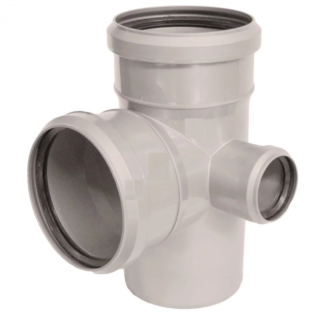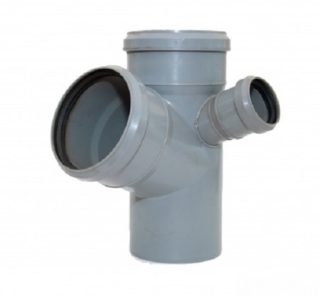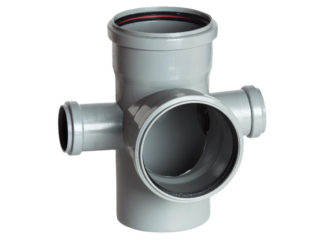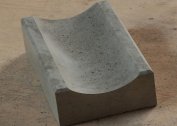Crossings are used for the convenience of wiring the sewage system. They are needed to install several outlets from the main sewer risers that carry household waste water inside residential and industrial buildings.
The purpose of the cross and the material of manufacture
The crosspiece is an indispensable element in the sewer pipe, used to connect additional communication branches. Plumbing products are made from durable material. They have a smooth inner surface, which helps to reduce the risk of clogging in the sewer line.
Modern fittings are made of polypropylene and PVC. Polypropylene products are wear-resistant, do not emit excessive noise, work great at temperatures up to 95 degrees. They are also immune to a variety of chemicals, do not need additional coating or painting before use. A high-quality cross is quite elastic, which means that its use contributes to the smooth operation of the sewer system for half a century.
Polyvinyl chloride parts are slightly less durable and wear resistant. But they are cheaper.
Cast iron crosspieces for distributing sewer pipes have not gone out of use. Due to its strength, Cheka are used in industry, mining enterprises, chemical plants and other types of industries.
Cast iron products, compared to plastic counterparts, weigh more and are more difficult to install. However, for industrial networks, their wear resistance is becoming a key indicator.
Types and sizes of devices
Crossings belong to the types of fittings for sewage. They are also called fan splitters. According to the configuration in space, the devices are divided into three types:
- Single-plane fittings are needed to connect auxiliary branches to the main pipeline in one plane.
- Two-plane splitters are used to install bends in two planes - from the main highways to plumbing fixtures.
- A three-plane view of sewer crosses is used in the arrangement of non-standard planning sanitary facilities. The fitting allows you to connect several pipelines into a single complex.
A two or three-plane sewer device with five exits is called a pyaternik.
Fan splitters are also divided into straight and oblique. The first option is used for connecting sewer pipes located in perpendicular planes relative to each other. In the second case, the branch angles can have different values - 90 and 135 degrees.
Devices differ in size, which is indicated in the marking. Crosses of a simple type are marked three-digit 110х110х110. This reports that all outputs have a cross section of 110 millimeters. Such a part may be suitable for installation with a lying system. A part with a larger or smaller cross-section can only be connected using a special insert.
A marking of 110x110x50 45 type suggests that one branch pipe from the riser has a cross section of 110 millimeters, and the second 50. The fourth figure implies that a pipe of a smaller diameter is diverted at an angle of 45 degrees. This type of splitter has its advantages when wiring to the toilet and an additional branch to other points, for example, to the washbasin.
Selection recommendations
When purchasing fan splitters, check the device for cracks, chips, or other defects. Also inspect rubber seals. They should not be jammed, otherwise after installation the connection will “siphon”.
For connecting sections of horizontal direction in the sewer during the assembly of joints under the ceiling, the use of straight crosses will be the best option.
Two baths located on both sides of the riser are connected to the sewer line only with the help of an oblique device. Installation of such splitters should not be carried out in a horizontal direction. This is explained by the fact that with a volley discharge of one or several branches, hydraulic shutters are likely to fail.
If you are not sure how many plumbing fixtures will be connected in the new bathroom, it is rational to mount a pyater. Unnecessary conclusions are simply closed by stubs. They are subsequently removed when summing up a bidet or shower.
Installation Rules
Before starting installation work in an apartment building, you will need to notify the neighbors so that they do not temporarily use plumbing fixtures. Then it is necessary to shut off the water supply and free the workplace from foreign objects.
If you plan to replace the old splitter, you must first dismantle the worn part. Even dilapidated cast-iron splitters are strong enough to break with a hammer, you need to make a considerable effort. It is necessary to caulk the joints and loosen the fitting at the joints. When performing such work, accuracy is required to avoid damage to entire elements.
Before assembly, it is better to handle the joints with a silicone plumbing sealant. This will facilitate an easy and reliable connection, prevent possible leaks and the appearance of fungus.
Installation of crosses can be carried out in a vertical plane on the main sewer branches and in the horizontal - in additional branches.
In the first case, the installation is carried out in this way:
- A drain pipe is mounted on which the crosspiece will be planted.
- The rubber sealant is coated with plumbing silicone.
- The splitter is placed so that the taps are located in the same plane with the supporting wall.
- The structure is temporarily fixed to the wall so that 50–70 mm remains to the crosspiece for the convenience of the subsequent installation of pipes.
- The branch in the vertical direction is mounted.
- According to the general technology, horizontal bends are installed, taking into account the slope of the pipe segments towards the splitter at an angle of 3-5 degrees.
After installing all the bends, the crosspiece is rigidly fixed to the supporting wall.
In the horizontal direction, the structure is mounted taking into account the inclination of the outlet pipe at an angle of 3-5 degrees to the horizontal plane. Installation is carried out in five stages:
- Mounting and securing the outlet pipe.
- Processing of plumbing silicone joints.
- Mounting the splitter in compliance with the slope.
- Alternate installation of the direct inlet pipe, taking into account the angle of inclination and side pipes.
- Fixing the resulting design with clamps and guides.
Arrangement of a splitter of a complex configuration with branches of different sections is carried out similarly, while taking into account the location of the outlet elements in the directions.
If leaks of the sewer riser are found, the cross itself will also need to be checked: a crack may form in it over time. In this case, solving the problem will be simple. Replacing the splitter is much easier than removing the riser. It costs a new part inexpensively - from 200 rubles.







